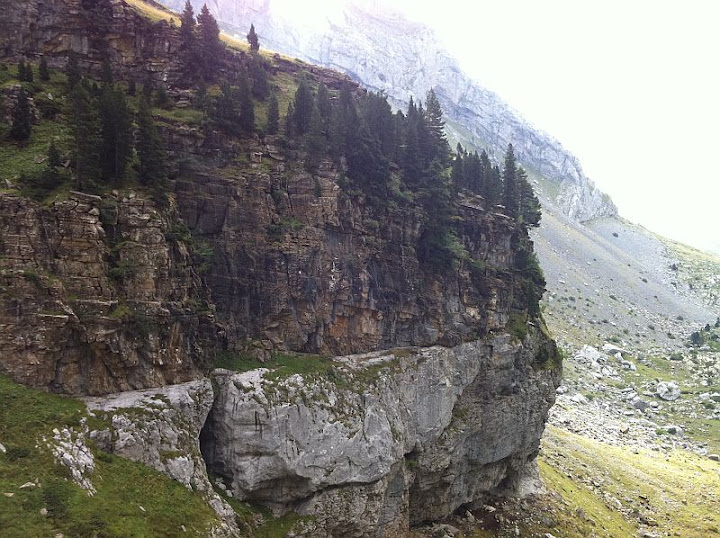Here is an interesting pair of photos taken in the Spanish Pyrenees which illustrate several hugely important geological concepts.

Thrust fault in the Spanish Pyrenees. limestone below and siltstone on top of it. Siltstone layer is older than limestone layer despite being on top of it.

The same rock formations but this time in normal stratigraphical positions (younger on top of the older).
So, what is going on here and how is it important? It is obvious that there are two distict rock formations on the first image. The gray layer is composed of limestone and on top of it is siltstone. We know that usually younger rocks are on top of the older ones but this isn’t true in this particular case. The limestone formation is younger than the siltstone formation. Note how it looks like the lower limestone formation is cutting the bedding of the siltstone formation. It shouldn’t be that way if the silt was deposited on top of the eroded surface of the limestone formation. There is a fault plane between them which means that the upper formation is pushed on top of the lower one. Such faults are called reverse or thrust faults and they are very common in mountainous areas.
Now if we move on to the second image (to do that I had to climb few hundred meters up in the mountains) we see that the order of rocks is reversed — limestone is on top of the siltstone formation. This is normal succession because younger rocks lay on the older ones. There is no fault plane between these formations but these rocks are not where they originally were — geologists say that they are allochthonous. It means that they have been moved from their original location but in this case they did so together as one block.
It is important to understand that the limestone formations on both photos are the same (more or less). We just have several copies of one crustal layer, one pushed on top of the other. The whole thing is hugely important in geology because that’s how mountains are mostly made and this particular set of outcrops in my opinion is especially good real-life illustration. In most cases it isn’t so easy to understand what is going on because rocks in mountainous areas are often severely folded and metamorphosed. Here you see only little folding on the second image and the rocks are not metamorphosed. Another very important aspect is that the blocks that were moved are relatively small. This is different in the Alps, for example, where it is much harder to to see and understand what is going on.
‘This is normal succession because younger rocks lay on the older ones.’
s/b ‘lie on the older ones’
Why do you think so?